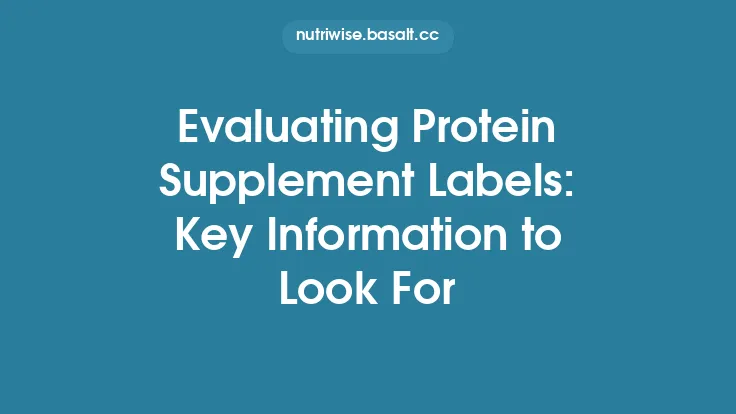Living with food sensitivities can turn everyday choices into a maze of labels, ingredient lists, and hidden pitfalls. While a balanced diet remains the cornerstone of health, many individuals discover that certain nutrients are harder to obtain when common allergens—such as gluten, dairy, soy, nuts, or shellfish—must be avoided. Supplements can bridge these gaps, but only when they are formulated with the same care and vigilance applied to food choices. This guide walks you through the essential considerations for selecting allergy‑friendly supplements, highlights nutrient sources that sidestep typical triggers, and offers practical strategies for building a safe, effective regimen that supports long‑term wellness.
Understanding Food Sensitivities and Their Impact on Supplement Choice
Food sensitivities differ from classic IgE‑mediated allergies in that they often involve non‑immune mechanisms (e.g., enzymatic deficiencies, histamine intolerance, or gut‑derived reactions). Nevertheless, the practical outcome is similar: exposure to the offending food can cause gastrointestinal distress, skin eruptions, respiratory symptoms, or systemic inflammation. When it comes to supplements, the same triggers can be present in excipients, binders, flavorings, or the active ingredient itself.
Key points to keep in mind:
- Hidden Sources – Many “inactive” ingredients, such as maltodextrin (derived from wheat) or casein (milk protein), can provoke reactions.
- Cross‑Contact – Manufacturing lines that process multiple allergens can lead to trace contamination, even if the final label lists none.
- Digestive Tolerance – Some individuals with sensitivities also experience heightened gut permeability, making them more susceptible to irritants like artificial colors or preservatives.
Understanding these nuances helps you evaluate supplements beyond the headline claim of “vitamin C” or “fish oil” and focus on the full formulation.
Common Food Allergens Found in Supplements
| Allergen | Typical Supplement Role | Common Sources in Formulations |
|---|---|---|
| Gluten (wheat, barley, rye) | Binder, filler, flavoring | Maltodextrin, wheat starch, barley malt extract |
| Dairy (casein, whey) | Protein source, coating | Calcium carbonate (derived from dairy), lactose as filler |
| Soy | Emulsifier, filler | Soy lecithin, soy protein isolate |
| Tree nuts & peanuts | Oil carrier, flavor | Almond oil, peanut oil, nut-derived extracts |
| Shellfish | Omega‑3 source | Krill oil, shrimp-derived enzymes |
| Egg | Binding agent, coating | Egg white protein, lysozyme (egg‑derived) |
| Corn | Sweetener, filler | Dextrose, corn starch, corn syrup solids |
When scanning a supplement label, watch for these terms and their derivatives. Even “natural flavor” can conceal any of the above, so a transparent ingredient list is essential.
Key Nutrients Often Needed by Those with Food Sensitivities
People who must eliminate multiple food groups may find themselves short on certain micronutrients. Below are the most frequently deficient nutrients and allergy‑friendly sources:
- Vitamin D – Essential for bone health and immune modulation. Look for cholecalciferol (D3) derived from lichen (plant‑based) or fish‑oil that is certified free of shellfish allergens.
- Calcium – Critical for skeletal integrity. Calcium citrate or calcium carbonate sourced from mineral deposits (not dairy) are safe options.
- Omega‑3 Fatty Acids – EPA/DHA support cardiovascular and neurological function. Algal oil provides a plant‑based, shellfish‑free alternative to fish oil.
- Iron – Needed for oxygen transport. Ferrous bisglycinate is a highly bioavailable, low‑irritant form that avoids the common iron‑sulphate fillers derived from soy.
- B‑Complex Vitamins – Particularly B12, B6, and folate, which can be limited in restrictive diets. Cyanocobalamin (synthetic B12) and methylfolate are typically free of allergens.
- Magnesium – Supports muscle relaxation and nerve function. Magnesium glycinate or citrate derived from non‑soy sources are well tolerated.
- Zinc – Important for immune health. Zinc picolinate or zinc citrate are generally free of gluten and dairy.
- Probiotics & Digestive Enzymes – Aid gut barrier function. Look for strains cultured on non‑dairy media and enzyme blends that use plant‑derived cellulase, amylase, and protease.
Hypoallergenic Supplement Forms and Delivery Methods
The physical form of a supplement can influence both allergen exposure and tolerability:
- Gelatin‑Free Capsules – Made from hypromellose (HPMC) or pullulan, these avoid animal‑derived gelatin and often have fewer filler requirements.
- Softgels with Plant‑Based Shells – Some manufacturers use tapioca or rice starch shells, eliminating common allergens.
- Powders – Offer flexibility for custom dosing but may contain anti‑caking agents like silicon dioxide (generally safe) or maltodextrin (wheat‑derived). Choose powders labeled “gluten‑free” and “dairy‑free.”
- Liquids/Tinctures – Typically emulsified with MCT oil (coconut‑derived) or glycerin. Verify that the carrier oil is not derived from soy or nut sources.
- Sublingual Tablets or Sprays – Bypass the digestive tract, reducing exposure to gut‑related sensitivities. These are often formulated with minimal excipients.
- Transdermal Patches – Provide a non‑oral route for nutrients like vitamin D or magnesium, eliminating ingestion‑related allergens entirely.
Reading Labels: What to Look for and What to Avoid
A thorough label audit is the cornerstone of safe supplement selection:
- Allergen Declaration – Look for a dedicated “Allergen Statement” that lists any potential cross‑contaminants.
- “Free From” Claims – Verify that “gluten‑free,” “dairy‑free,” or “soy‑free” are backed by third‑party certification rather than marketing fluff.
- Ingredient Order – Ingredients are listed by weight; the first few items are the most abundant. If maltodextrin appears near the top, the product may not be suitable for gluten‑sensitive individuals.
- Additives & Preservatives – Avoid artificial colors (e.g., Red 40), flavors, and preservatives like sodium benzoate if you have histamine intolerance.
- Dosage Form Details – Check for “enteric‑coated” or “delayed‑release” technologies that may use shellac (derived from insects) or other allergens.
- Expiration and Stability – Some hypoallergenic formulations have shorter shelf lives; ensure you can use the product before degradation occurs.
Certified Allergen‑Free and Third‑Party Tested Products
Certification adds a layer of confidence:
- NSF Certified for Gluten-Free – Guarantees <20 ppm gluten.
- USP Verified – Confirms ingredient purity, potency, and absence of harmful contaminants.
- Allergen‑Free Certification (e.g., Allergy Certified by the Allergy Research Group) – Indicates rigorous testing for the 14 most common allergens.
- Informed‑Sport or Informed‑Choice – While primarily aimed at athletes, these programs also test for hidden allergens and contaminants.
When a product carries any of these seals, it has undergone independent testing that goes beyond the manufacturer’s internal quality control.
Plant‑Based and Gelatin‑Free Capsules: Options and Considerations
Hypromellose (HPMC) capsules are derived from cellulose, a plant polymer, and are inert, making them ideal for sensitive users. Pullulan capsules, made from fermented tapioca starch, offer a clear, glossy appearance and dissolve quickly in the stomach.
Pros:
- No animal‑derived gelatin, eliminating concerns for those with egg or bovine sensitivities.
- Typically free of common allergens like soy and gluten.
Cons:
- May have a slightly lower tensile strength, affecting the stability of moisture‑sensitive ingredients.
- Some manufacturers add a thin coating of glycerin or sorbitol, which can be problematic for individuals with fructose intolerance.
Choosing a reputable brand that discloses the exact capsule composition helps mitigate these issues.
Liquid, Powder, and Sublingual Alternatives for Sensitive Individuals
- Liquid Formulations – Often emulsified with MCT oil (coconut‑derived) or sunflower oil. Ensure the carrier oil is not soy‑based.
- Powders – Look for “single‑source” powders where the only filler is a certified gluten‑free maltodextrin derived from corn, or better yet, a pure mineral matrix (e.g., calcium carbonate).
- Sublingual Sprays/Tabs – Provide rapid absorption and bypass the gastrointestinal tract, reducing exposure to gut‑related allergens. These are especially useful for vitamin B12, vitamin D, and magnesium.
When using powders, it’s advisable to mix them with a neutral base (water, oat‑milk alternative) rather than dairy or soy milks.
Selecting High‑Quality Omega‑3 Sources Without Common Allergens
Omega‑3 fatty acids are a frequent supplement need, yet traditional fish oil capsules often contain soy lecithin as an emulsifier and may be processed on lines that handle shellfish. Allergy‑friendly alternatives include:
- Algal Oil – Derived from marine microalgae, providing EPA/DHA without fish, shellfish, or soy. Most algal oils are encapsulated in HPMC capsules.
- Krill‑Free Marine Oils – Some manufacturers use sustainably harvested krill oil that is processed in dedicated facilities; however, verify that the product is certified shellfish‑free.
- Flaxseed Oil – A plant‑based ALA source, but ensure the oil is cold‑pressed and stored in amber glass to prevent oxidation.
Check for oxidation markers (e.g., peroxide value) on the label; low values indicate freshness and reduced risk of gastrointestinal irritation.
Calcium and Vitamin D Options Free of Dairy and Soy
- Calcium Citrate – Highly absorbable and typically free of dairy. Look for mineral‑derived calcium rather than calcium carbonate sourced from oyster shells.
- Lichen‑Derived Vitamin D3 – Offers a vegan, allergen‑free source of D3, unlike the more common lanolin (sheep wool) derived form.
- Combined Calcium‑Vitamin D3 Softgels – Choose formulations that use HPMC shells and MCT oil as the carrier.
If you prefer a powder, a calcium‑magnesium‑vitamin D blend using calcium citrate and lichen D3 can be mixed into a non‑dairy beverage.
Iron and B‑Complex Supplements for Sensitive Stomachs
Iron supplements are notorious for causing GI upset, and many contain soy‑derived binders. Allergy‑friendly options:
- Ferrous Bisglycinate – A chelated form that is gentle on the stomach and typically free of gluten, dairy, and soy.
- Heme Iron Polypeptide – Derived from animal hemoglobin but processed without soy or dairy additives; suitable for those without red‑meat restrictions.
- B‑Complex (Methylated Forms) – Methylcobalamin (B12) and methylfolate (B9) are often produced synthetically without allergenic carriers. Look for capsules using HPMC and a minimal filler such as rice flour.
Take iron with vitamin C (ascorbic acid) to enhance absorption, but ensure the vitamin C source is not derived from citrus extracts that may contain hidden sulfites.
Probiotic and Enzyme Supplements Without Gluten or Dairy
- Probiotic Strains – Lactobacillus and Bifidobacterium species can be cultured on soy‑free media. Brands that explicitly state “non‑dairy, gluten‑free” and use a maltodextrin (corn‑derived) carrier are safest.
- Enzyme Blends – For those with lactose intolerance, lactase enzymes derived from fungal sources (e.g., Aspergillus niger) are appropriate. Ensure the capsule shell is HPMC and that the formulation does not contain wheat‑derived maltodextrin.
Stability is key: look for products with a guaranteed CFU count at the end of shelf life, not just at the time of manufacture.
Managing Cross‑Contamination Risks in Manufacturing
Even with clean ingredient lists, cross‑contamination can occur. Mitigation strategies include:
- Dedicated Production Lines – Choose brands that run allergen‑free products on separate equipment.
- Batch Testing – Verify that the manufacturer conducts batch‑level testing for the 14 major allergens.
- Transparent Supply Chain – Companies that disclose their raw material sources (e.g., “calcium carbonate sourced from US mines”) provide an extra layer of assurance.
- Storage Recommendations – Keep supplements in a dry, temperature‑controlled environment to prevent mold growth, which can introduce hidden allergens like fungal spores.
If you have severe sensitivities, consider requesting a Certificate of Analysis (CoA) from the manufacturer.
Practical Tips for Building an Allergy‑Friendly Supplement Regimen
- Start with a Baseline Assessment – Identify which nutrients you’re most likely to lack based on your restricted foods.
- Prioritize Whole‑Food Sources First – Supplements should fill gaps, not replace a varied diet.
- Introduce One Product at a Time – This helps you pinpoint any unexpected reactions.
- Maintain a Symptom Diary – Record dosage, timing, and any adverse signs; share this with your healthcare provider.
- Rotate Brands Cautiously – Switching to a new brand can re‑introduce allergens; give a 2‑week washout period before testing a new product.
- Store Supplements Properly – Use airtight containers, avoid humidity, and keep them out of direct sunlight.
By following a systematic approach, you can confidently incorporate supplements without compromising your allergy management plan.
When to Consult Healthcare Professionals
While many allergy‑friendly supplements are safe for self‑administration, certain scenarios warrant professional guidance:
- Complex Sensitivities – If you react to multiple food groups, a registered dietitian can help map nutrient gaps and recommend targeted supplements.
- Medication Interactions – Supplements like calcium, iron, or magnesium can interfere with prescription drugs (e.g., antibiotics, thyroid medication).
- Pregnancy, Lactation, or Chronic Illness – Even though these topics are outside the scope of this article, they require specialized advice.
- Persistent Symptoms – Ongoing gastrointestinal or dermatologic reactions may indicate an underlying issue beyond simple food sensitivities.
A qualified practitioner can also order laboratory tests (e.g., serum 25‑OH vitamin D, ferritin, zinc) to verify that your supplement regimen is achieving the desired biochemical outcomes.
By understanding the hidden sources of allergens, selecting rigorously tested hypoallergenic formulations, and employing a disciplined approach to supplementation, individuals with food sensitivities can safely close nutritional gaps and support their overall health. The key lies in vigilance, education, and partnership with trusted manufacturers and healthcare professionals—ensuring that every capsule, powder, or liquid you take truly aligns with your unique dietary needs.





